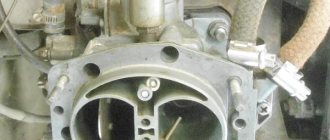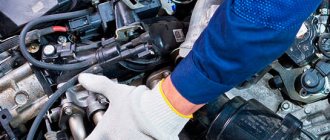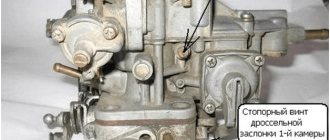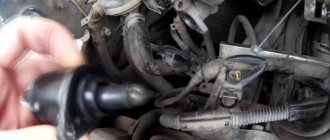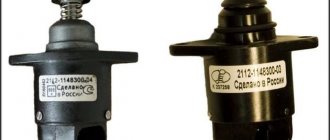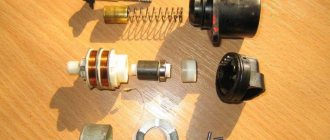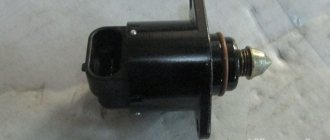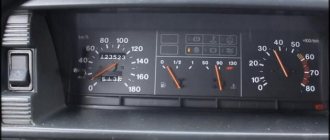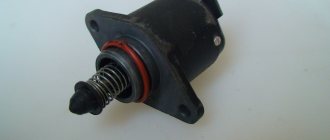Print this article Font size 16
If there are problems with the operation of the idle speed sensor, difficulties may arise with controlling your VAZ 2109. To determine the breakdown and learn how to correctly change the sensor, we will introduce you to the basic principles.
Appearance of the device
Device
The VAZ 2109 carburetor consists of two main elements - the body and the cover. All parts are mainly located in the housing (pump, jets, float, etc.). Also, the power system, which may be associated with repairs, includes: candles, EPHH, and so on.
When the pump pumps fuel from the tank, it first enters the carburetor float chamber block. This chamber is also called the first or primary. It serves to maintain an optimal level of gasoline at which the carburetor can operate normally and maintain stable speed. At the entrance to the chamber, there is a special fitting through which fuel passes. Its quantity is controlled by the valve, as well as several floats. When you lightly press the gas pedal, the amount of gasoline entering the chamber, and accordingly its pressure, decreases sharply. In order for the flammable mixture to enter the chamber normally, at low pressure, the valve rises higher, clearing the way. This process is continuous and runs as long as the engine. The valve structure is closely connected to the float. This control scheme eliminates the chance of spark plug overflow.
When you sharply press the gas pedal, a large amount of fuel enters the primary chamber block. In order to protect the candles, there is a secondary chamber. It opens when the engine speed is high. The first chamber, with the accelerated movement of fuel, pours it into the second, and ensures a uniform, enriched mixture when it enters the cylinder, thereby preventing pedal failure.
For normal operation of the VAZ 2109 engine, simply gasoline is not enough. The carburetor must also receive air. It enters through the valve into the float chamber block, where it is mixed with fuel and forms a flammable mixture.
In addition to when the VAZ 2109 car is in motion, it can also be stationary, but with the engine running. Here a device such as idle speed is already triggered. It is regulated separately, supplying fuel through a solenoid valve to the float chamber. The idle control circuit includes an electronic device - an economizer. It activates the solenoid valve at speeds below 1700 rpm and deactivates when the gas pedal is pressed.
It is very important to know that food does not always pass through an economizer. Sometimes, the idle circuit bypasses this device, turning on the solenoid valve directly from the ignition.
Also, the carburetor has such a device as: the EPHH control unit. It serves to reduce the amount of exhaust gases and reduce fuel consumption. The EPHH control unit, on a VAZ 2109 car, is mounted separately from the entire power system. For example, when a car is moving downhill while in gear, the gas pedal is completely released. At the same time, the throttle valve closes and the EPHH control unit is activated, raising the solenoid valve.
Operating principle
When the car is moving and the throttle valve is open, the IAC is not involved in the process, its valve is closed and the rod is motionless. When the damper closes and the engine goes into idle mode, voltage is applied to the electric motor and the rod moves towards the opening - the valve comes into operation. It opens slightly, and air enters the engine bypassing through a special hole.
When the driver turns on the ignition, the IAC rod fully extends to its extreme position and closes the calibration hole in the throttle pipe. The sensor then counts the steps and the valve returns to its home position. As for this basic position, it can be different and depends on the firmware installed in the ECU. For January 5.1 firmware the position is 120 steps, for Bosch firmware it is 50 steps.
Operation and repair
The VAZ 2109 carburetor, like all other parts, tends to break. Typically, a breakdown involves the failure of any spare part. In such cases, repair usually helps.
The first thing that can break is the accelerator pump. Its purpose is to enrich the fuel mixture, regardless of the air supply, when the throttle valves are opened. If, when you sharply press the gas pedal, the car jerks, it means that there is either not enough fuel, and significant gaps occur in the supply, or, on the contrary, there is too much of it, and it overflows the spark plugs. So, to avoid this problem, an accelerator pump is used. It regulates the exact amount of fuel required for normal engine operation, even when the gas is pressed hard.
The accelerator pump more often becomes clogged with sediment than breaks down, and then repairs are not needed, but simply cleaning is enough. But, if this is not the case, but there is still a breakdown, then the pump needs to be repaired urgently, otherwise operation of the engine of the VAZ 2109 car will be impossible, and you are guaranteed to have pedal failures.
The first symptoms that the pump is faulty is that when you press the pedal, the speed does not increase steadily, but floats. This is due to a shortage, or vice versa, an excess of fuel. The spark plugs do not have time to burn out all the gasoline, and they are simply flooded, so the car jerks while driving. Also, the pedal may fail when pressed.
Repair for such a breakdown is as follows:
We take out the sprayer; Shake it. If there is a characteristic knocking sound of the ball inside, then the sprayer is working, if not, then this will be the reason why the pedal failed; The pump has a rather heavy structure with parts. A large number of holes and channels increases the chance that the pump will clog, and pedal failure will be inevitable. If the holes are clogged, then repairs are not needed. You just need to buy carburetor cleaning fluid and use it to blow out the channels.
If the VAZ 2109 jerks when idling, and there are dips when you sharply press the gas pedal, then the EPHH control unit has a malfunction. Its repair primarily depends on which control unit is installed. They can be 4 or 6 pin. Repair of EPHH must be carried out by a specialist. If you do not have the appropriate knowledge, simply replace the part with a new one.
The reason that the VAZ 2109 jerks when driving, or even stalls, and when you press the gas pedal, failures occur, may be not only the carburetor or the EPHH control unit, but also the spark plugs. When used for a long time, carbon deposits appear at the contact site. Because of it, the spark plugs do not completely burn out the fuel in the cylinder.
Sometimes the spark plugs flood even at idle. This is due to the fact that the EPHH control unit is selected incorrectly. The valve opening does not occur synchronously, and the engine speed fluctuates. At the same time, gas pedal failures and late ignition are observed. In order to understand which EPHH is better to install, you need to decide on the choice of carburetor jets. The type of device depends on their diameter.
In general, before repairing the carburetor, make sure that the speed is fluctuating precisely because of it. Also, gas pedal failures occur for this reason. After all, maybe the candles are to blame for everything. If they are flooded, the car will jerk and stall. But in this case, the cause must be sought in the fuel lines, pump and similar components. But this is better than repairing the carburetor, since this work is quite painstaking.
If you find an error, please select a piece of text and press Ctrl+Enter.
Source
Checking the intake air pipe
If your vehicle has an air filter installed separately in the airbox, inspect everything from the rear to the throttle body(s). On the air box, check all hose connections and make sure the clamps are in good condition.
Make sure all clamps that seal the inlet port are secure. 1 – THROTTLE BLOCK. 2 – WORM BAND CLAMP. 3 – CAM CONNECTION OF THROTTLE VALVE. 4 – INLET MANIFOLD.
Pull back the intake port to check for hidden cracks underneath. 5 – AIR FILTER BOX. 6 – PLACE PROPOSED TO CRACKS. 7 – BENDS.
Replace the air filter if it is so dirty that light from a 100-watt light bulb cannot pass through the filter element. Make sure the new filter is properly seated in the air box and that the cover is seated tightly and the clips are straight. Inspect the air flow line towards the throttle body, tightening all clamps and clamps along the way. If the line has a built-in mass air flow meter, check for leaks in its connections.
Large, corrugated rubber intake air lines are prone to cracks between bends on the underside of the tubes. They are usually not visible until you disconnect one end of the pipe and bend it back to take a good look from underneath. If the engine management measures airflow using the manifold pressure sensor (MAP sensor), this type of leak will not affect idle quality. But the hole still needs to be sealed, or additional dirt and dust will get inside. If the engine uses an airflow sensor, this type of leak will manifest itself as a noise as the engine moves forward on its mounts and opens the crease wide open.
The engine then gets an unmeasured excess breath of air and revs up on its own. Idle speed control can try to catch a sudden increase in speed by closing the bypass channel. Then, when the engine returns to normal and the crack closes, the idle speed will be too low. In response, adjusting the idle speed can open the channel again to raise the speed. This scenario can go into a cycle, causing the idle to become rough and alternating.
If you don't mind a little mess in your engine bay, there's another quick way to check your intake air path and leaks. Simply spray carburetor cleaner onto the connections and around the intake manifold while the engine is running.
Spray carburetor cleaner around the throttle body to check for air leaks.
If the RPM changes while spraying, it means vapors are somehow getting in. So you'll have to play spy to find the leak. Don't spray near a dispenser - if you have one - because there is a chance the solvent will ignite and leave you without eyebrows or nose hair.
EPHH VAZ 2109
Almost all VAZ models with a carburetor power system are equipped with a forced idle economizer. EPHH VAZ 2109 is an electronic device designed for: a) To save vehicle fuel; b) To prevent the supply of fuel to the engine when it is turned off; c) To cut off the fuel supply to the engine through the idle system during engine braking.
The economizer consists of the following parts: 1) Economizer module 2) Solenoid valve 3) Throttle valve limit switch. Remember, if at least one of these nodes is faulty, the EPHH will not work. Let's look at how this block reduces the fuel consumption of a VAZ car. The block has input and output circuits. The economizer input circuits are the throttle valve limit switch and the wire connected to the switch. What information do they provide? a) The throttle limit switch tells you whether the gas pedal is pressed or not. If the gas pedal is not pressed, the limit switch is shorted to ground. As soon as the gas pedal is pressed by the driver, this contact disappears.
Throttle limit switch
b) Pulses to the ignition coil are read through a wire connected between the economizer and the switch. This is done so that he knows the actual engine speed of the car.
The economizer reads pulses onto the coil from the commutator
Location
Knowing the principle of operation of the VAZ-2109 idle speed sensor (injector), it is not difficult to guess where it should be installed. On this vehicle it is located near the throttle valve and throttle position sensor. The device is fixed with screws on the damper body. In case of failure, the car owner can easily replace it himself.
Where is the wire of the idle speed sensor 2109 connected?
The operation of an internal combustion engine has many characteristics, but for a car owner “not armed” with knowledge and instruments, the main sign of engine health is the speed. When driving, the engine experiences different loads. Which one should you choose as your starting point?
The only possible mode, regardless of the device and fuel supply system, is a mode in which the transmission is disconnected from the engine. By setting the speed knob to the neutral position, we ensure that the motor is not loaded. This mode is called idle operation - x.x.
Diagnostics on the stand
The simplest stands for checking IAC will cost the average car enthusiast 1,500-2,000 rubles. Replacing the idle speed sensor on a VAZ-2109 will cost 300 rubles. Therefore, purchasing a stand is not economically feasible. You can assemble a simple stand with your own hands. The circuit consists of a charger from any mobile equipment with a voltage of 6 V, a plug block and a test lamp. If the lamp lights up during the test, then the IAC is faulty. If the lamp burns at half intensity, then the device is working properly.
Idle speed sensor VAZ 2109
It is in this mode that you can determine the health of the motor without special measurements. Let us recall that the operation of the fuel supply system is controlled by dampers that are rigidly attached to the mechanics. In x.x mode. they are closed. In simple terms, the engine will not start, regardless of its type. To enrich the mixture, in idle mode. a simple device is provided. Car owners call this barrel by different names: regulator, valve, coolant sensor. — JHH. You should pay attention to its work in the following cases:
- When the gear selector is set to neutral, the engine suddenly stalls;
- when starting a cold engine, reaching higher speeds causes difficulties;
- when idling, you can clearly hear the speed “swimming”;
- RPM drop when: on. stoves, fans, high beam headlights, etc.;
- a sudden sharp decrease or increase in speed for no apparent reason.
The sensor is designed simply: the electrical part is a simple step-by-step electric motor. When voltage is applied, a mechanical part—a spring-loaded needle or a conical rod—moves forward or backward along the air channel. Moving in steps (steps), the needle changes the diameter of the channel gap, regulating the volume of air mixture entering the fuel.
An obvious misconception: neither in the injection nor in the carburetor version, and regardless of the type of engine, the IAC is not mechanically adjusted - the fuel system adjusting screws do not affect the sensor. Its serviceability can be determined indirectly using a multimeter. In carburetor VAZ 2109, the sensor is installed on the carburetor pipe, in the form of a cylindrical barrel with wires suitable for the block. If you remove the negative terminal of the battery, and then the block with wires from the sensor, the winding designations are visible on the terminal terminals of the sensor: A, B, C, D. The internal resistance between AB and CD should be in the range of 36-82 ohms, and the terminals of different windings: A-C or B-D should not “ring” at all. If you put the block with wires back on the removed sensor and connect the “-“ terminal, turn on the ignition, you should hear faint clicks and the needle moving. Malfunctions of the mechanical part: remove the sensor and rinse (blow out) the air channel, visually check the condition of the needle (cone) and seal gaskets.
So, all the work is in vain: the sensor does not work and needs to be changed.
Replacing the idle speed sensor will require removing the air filter. It is necessary step by step:
— find the sensor in the area of the carburetor flaps using the wires coming to it.
— disconnect the “–” terminal of the battery, remove the connector with wires, unscrew the two fastening screws of the sensor (in models with a Solex carburetor, the sensor is unscrewed along the thread with an 8-12-13 wrench, depending on the model), carefully remove the DXX.
— clean the sensor installation surface, install a new one, doing everything in reverse order.
On the “nine” with an ECU (electronic control unit), the new DXX is not adjusted. After replacing, you should start the car. After 5-10 seconds. The nominal parameters of the DXX will be set automatically from the installation of the electronic unit. Attention: the electronics will not calibrate the sensor if the battery terminal is not disconnected when replacing!
If there are problems with the operation of the idle speed sensor, difficulties may arise with controlling your VAZ 2109. To determine the breakdown and learn how to correctly change the sensor, we will introduce you to the basic principles.
The engine does not idle: the main reason
The first thing you need to pay attention to is the solenoid valve. However, it is not installed on all VAZ 2106 carburetors. It is this small device that most often falls into disrepair. Its operating principle is similar to a solenoid relay - there are windings, an armature, and a return spring, but the dimensions are somewhat smaller.
The function of the solenoid valve is to open the path for gasoline to flow (with the throttle valve closed) when the ignition is turned on. And close when disconnected, respectively.
The most common breakdowns of the solenoid valve, as a result of which the idle speed disappears:
- The winding is destroyed, the armature with the needle does not move, fuel is not supplied.
- The fuel nozzle located on the edge of the valve is clogged.
- The valve armature is jammed due to deformation.
You can check this device very quickly; you will need a small piece of wire, stripped from both edges. Connect one end to the positive side of the battery, and connect the other end to the terminal of the solenoid valve. There should be a fairly loud click, but if it doesn’t, then most likely the winding is damaged.
If there is a click, remove the wire connected earlier and turn on the ignition. Place the power connector onto the valve. If there is no click, then the wiring is damaged. In the event of a breakdown, there can be three exits, you can use any:
- If the solenoid valve is completely destroyed, it would be wise to unscrew it and remove the tip (fuel nozzle). And thus get to the nearest store without much difficulty. The price of a new VAZ 2106 solenoid valve is about 100 rubles, so repairs will not be expensive.
- Temporarily connect the output of the solenoid valve to the positive terminal of the battery - if the wiring is damaged. But in this case you will have to remove the wire during each stop.
- It would be much more efficient to run a wire from the solenoid valve output to the “+B” ignition coil contact. The fact is that voltage appears on it only after the ignition is turned on.
Functions
The IAC regulates the amount of air entering the engine when the throttle valve is closed. This suggests that the IAC performs the functions of automatically adjusting the specified engine speed when idling.
The regulator also takes part in the process of warming up the engine to optimal operating temperatures in winter. The operating temperature range of the IAC is quite wide - from -40 to +130 degrees Celsius.
The IAC, despite such important functions, is small in size and consists of three main elements:
- Stepper electric motor;
- Spring;
- A rod with a cone-shaped needle at the end.
The idle speed control is mounted on the throttle body with a pair of screws.
Design features of the regulator
The regulator is located in the throttle body and is usually secured with two screws. If the installation involves drilling out the top of the bolt, then complete removal of the damper will be required to clean the regulator. Main components of the sensor:
- regulator body;
- valve;
- ball bearing;
- spring;
- rotor;
- screw;
- stator winding;
- plug
According to the type of operation, regulators are divided into rotary, stepper, and solenoids. The solenoid type regulator operates on electromagnetic force. When voltage is applied to the coil, the core is retracted, the damper rises, opening access to air flow. When the solenoid is turned off, the damper closes. The design of the stepper regulator includes a ring magnet and four types of windings. Voltage is applied to each winding in turn, a magnetic field arises in which the rotor connected to the damper begins to rotate, and the mechanism opens and closes.
Rotary sensors have a similar operating principle to a solenoid; a rotor is used as the supply force.
Symptoms of a problem
Under no circumstances should you ignore signs of failure of the idle speed sensor on your injection or carburetor VAZ 2109. This will make driving uncomfortable at first, but can soon cause a serious accident.
There are several main symptoms that may indicate problems with ICC:
- The revolutions spontaneously begin to increase and decrease;
- When turning on a cold power unit, the speed does not increase;
- When using additional electrically dependent devices, such as headlights or a heater, the speed immediately begins to drop at idle;
- When shifting gears or idling, the engine may stall.
This is not a complete list of possible symptoms, but they are all indirect. Therefore, to make sure that the problem lies precisely in the IAC, and not in other engine components, it is necessary to check the current state of the sensor.
Checking status
To check the current state of your IAC on a VAZ 2109 car, follow several sequential steps.
Apply the handbrake on the car and install chocks under the wheels. Safety should always come first when doing DIY car repairs.
You need to get to the sensor you are looking for, disconnect it from the power supply with wires, and then use a voltmeter to check for voltage. The minus is placed on the engine, and the plus is installed on the terminals of the wire block A and D
Turn on the ignition, check the voltage readings. Normally they are about 12 Volts. If the voltmeter shows lower values, there may be a problem with the battery charge level. If there is no voltage at all, you will have to check the entire computer and electrical circuit. Breaks are possible.
Carry out another test with the ignition on. Check terminals AB and CD one by one. In normal condition, the resistance across them should be approximately 53 ohms. If the IAC is working normally, the meter will show infinite resistance
With the idle speed control removed and the ignition on, connect the power supply to it. If at the same time the conical needle moves out, everything is fine with the device. If the cone-shaped needle does not extend, then the IAC is out of order and requires replacement
Having determined that the old idle speed sensor has already served its purpose on the VAZ 2109, it needs to be replaced. The procedure is completely doable without outside help.
The simplest diagnosis of DXX
The easiest way to check the idle speed sensor of the VAZ-2109 is the following method. Need a friend's help. The sensor is disconnected from the connector, then the mounting screws are unscrewed and the device is dismantled. Next, the regulator will be plugged into the connector again, but held in your hands.
At this time, the assistant starts the power unit, and the IAC rod should at this moment retract completely and then extend to a certain distance. If the device behaves this way, then it is operational - the rod is not bent, it is not jammed inside the valve. But there is no guarantee that the device matches the ECU firmware. The rod extends, but the number of steps is unknown. There is a marking on the connector - you can use it to ensure that the ECU sensor matches.
This is the initial stage of diagnosis. Next, check the electrical part, the condition of the valve, and the degree of needle wear.
Replacement or cleaning
Practice shows that in a fairly large number of cases, simply cleaning the idle air regulator allows you to restore its functionality. Therefore, we advise you to try this method first. And if it does not give results, then it will not be difficult to replace the device.
- Buy a container of carburetor cleaner. In this case, your engine may well be fuel-injected. It’s just that this composition is excellent for cleaning IACs and more.
- Disconnect the connector with wires from the sensor, unscrew the two fasteners and remove the affected regulator itself.
- Clean the regulator from accumulated debris and contaminants, and be sure to clean the needle and spring itself. This should be done with carburetor cleaner. Use available tools to tidy up a fairly compact device.
- Be sure to clean the idle air control housing on the throttle assembly. This is where the cone-shaped needle of the XX sensor enters.
- After completing the cleaning of the device, return it to its place and check its operation.
- If cleaning does not bring the desired result, the engine continues to behave inadequately, you will have to purchase a new regulator and install it in place of the old sensor.
- Before replacing, be sure to turn off the power to the car by disconnecting the negative terminal from the battery, then disconnect the block with the power wires, unscrew the mounting screws and remove the device.
- Reassemble in reverse order.
As you know, replacing the idle speed sensor on a VAZ 2109 injector can be done with your own hands. This is not difficult to do. Replacing the idle speed sensor on a VAZ 2109 is a mandatory process, since imagining a car that does not have an idle speed is simply ridiculous. If you drive such a car in a city where there is a traffic light every half kilometer, it will be, to put it mildly, not comfortable. A car's idle speed sensor is as important a part as a fuel pump, carburetor or any other part.
Installation of a new IAC
Installation of the new device on the VAZ 2109 and 21099 is carried out in the reverse order: connect the wires, put them in place, and fix them with two bolts. But sometimes situations occur when, after replacement, the engine speed still fluctuates and no changes occur. So, in order to avoid such a nuisance, before installation, you should definitely check the new part.
To do this, connect the disconnected sensor to a multimeter. The positive wire goes to the coil, and the negative wire goes to the motor. Next, turn on the ignition and check the instrument readings. If they float around 12 V, then the device is working properly and is ready for use. But if the instrument scale readings show 0 V, then the part is definitely faulty. If, during the same check, the old, broken sensor also shows 12 V, but at the same time, the engine speed fluctuates during its operation, then the old device is working properly and needs cleaning.
The process of cleaning this part includes complete disassembly. Therefore, it is better to entrust this matter to a specialist, since carrying out the cleaning procedure yourself can completely break the device.
How does he work
The car performs a number of specific functions that are very important. If this part does not work well or fails, then it may be impossible not to turn off the car when you need to stop, for example, at a traffic light. Driving a car with a faulty idle speed sensor is not only uncomfortable, but also very dangerous. As soon as it is noticed that there is a problem with a given part, it may need to be repaired or replaced. The idle speed sensor is also called a regulator. On models such as the VAZ 2114 or other modifications of the Samara, this idle speed regulator is designed to stabilize idle speed. On the VAZ 2109 it performs a more complex function. The sensor is a small electric motor equipped with a conical needle.
This part is located in cars of the VAZ family on the throttle body, next to the damper. The idle speed sensor itself, which we will call IAC, is attached here with two screws. But it also happens that dismantling this element sometimes causes difficulties. And all this is due to the fact that in addition to fixing with screws, the DXX is mounted on varnish. Let's look at what happens when the ignition is turned on:
- At this moment, the rod located on the idle speed control moves completely forward, resting against a special calibration hole located in the throttle pipe.
- After this, the sensor begins to work. He counts the steps and returns the valve back. And the position of this very valve depends on the time of year and engine warm-up. For example, this could be equal to 50 steps with the motor running.
- As the steps increase or decrease, the air passing through the calibration hole is under constant change. When the rod is extended, the steps increase. The reverse process occurs when the rod returns to its original position. The stroke of the rod itself on the vase is approximately 250 steps.
- The idle speed is controlled by a sensor that is assisted by air. In other words, air entering the engine regulates idle speed.
- The mass flow sensor analyzes the incoming air based on its quantity. As for the controller, it supplies the required amount of gasoline or other fuel directly to the engine through the fuel injectors. Thus, the process of supplying the required volume of air occurs.
- As for a cold engine, the controller in this case increases the speed only due to the presence of the DXX. And this mode allows you to move away even without necessarily warming up the engine.
Principle of operation
It is not entirely correct to call the idle speed sensor a sensor. After all, they are measuring instruments that process and convert information, displaying it on mechanical or electronic indicators on the dashboard.
It is correct to call the idle speed sensor a regulator, or simply IAC. IAC plays an important role in engine operation, as it ensures the harmonious and correct behavior of the power unit.
Alas, the self-diagnosis systems on the VAZ 2109 are not perfect, therefore, if the idle air regulator fails, the car does not notify you about it even by turning on the Check Engine warning light. Therefore, you have to navigate by signs of breakdown.
The IAC works as follows. When the ignition switch is turned on, the rod on the sensor extends all the way and rests against a special hole in the throttle pipe. The IAC begins to read the steps and the valve returns to its original position. When the engine is running, increasing or decreasing the number of steps causes a change in the volume of air entering through the hole. Consequently, the required amount of air flows into the engine, ensuring stable operation of the engine at idle.
How to find out if the sensor is faulty
This is not so difficult to do, although the regulator is not equipped with a self-diagnosis system, when the results are sent to the on-board computer or a light-up panel device. Here are the main signs of a faulty DX:
- the car stalls at idle;
- There are absolutely no increased speeds on a cold engine;
- idle speed fluctuates;
- The car stalls when you try to change gear at the gearbox.
Carburetor
Why is there a loss of speed at idle? This often occurs after washing the carburetor. To verify that there is a problem, you must:
- park the car on the site;
- turn the engine to idle speed.
Instability of indicators when the engine is on and incorrect operation of other electrical appliances indicates a short circuit that has occurred in the on-board network. The breakdown can be eliminated by testing the wiring and checking the reliability of the terminal connections.
Moreover, the cables of old cars are often locked even after washing. The whole point is that water penetrates under the body and floods the wires. Here, first of all, you need to check the harness leading to the fuse box - it is located very close to the windshield drain and often suffers from moisture. The problem is eliminated by sealing.
In addition, a drop in speed both cold and hot often indicates that:
- the carburetor is simply not adjusted properly;
- the plug has become unusable;
- there were problems with the vacuum brake booster;
- The spark plugs are not working properly.
Setting the float chamber level
This is the first step in adjusting any carburetor. It is on this part that the consumption and stability of the engine will depend. The level must be at the nominal level set by the manufacturer, so it is very important to follow the technology.
Setting the fuel level in the float chamber: I - carburetor cover; 2 — needle valve seat; 3 - emphasis; 4 - needle valve; 5 - locking needle ball; 6 - valve needle pull-out fork; 7 — float bracket; 8 - tongue; 9 — float; 10 - gasket.
The top cover of the carburetor is removed, but before that, you need to pump up the manual fuel pump to check the set level. The nominal level is the level of gasoline located on half of the inclined surface. If it is higher or lower, then adjust the float level by bending the adjusting antennae. The XX speed is also regulated by the float chamber.
To check, just put the cover on top, start the engine and immediately turn it off. Open the lid again and check the level. After this, you can move on to the next stage.
